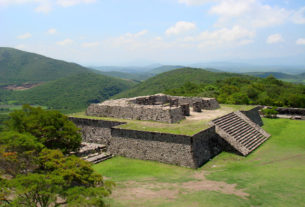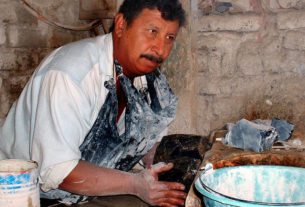The creative blending of diverse ingredients is the hallmark of Mexican cooking, and in the state of Puebla it is a passion. Everywhere there is talk of food. People give detailed accounts of what they’ve just eaten, plan to eat later, or what was served at the most recent fiesta. Their enthusiasm for the subject is born of pride in one of the oldest and most savory regional cuisines of Mexico.
Long before the Spaniards came to this area and built the city of Puebla, the nearby town of Cholula was a ceremonial center and home of pre-hispanic street food, which was sold to the worshippers who thronged to the great pyramid. The conquerors established Puebla as a center of their own religion, building several convents and monasteries. Poblano cuisine is a mixture of the traditional indigenous fare and the influence of the Spanish nuns, in whose grand conventos were born such specialties as chiles en nogada, mole poblano, and a variety of sweets bordering on the baroque.
The good sisters spent a great deal of their time cooking, and enthusiastically embraced the local ingredients. Tortillas and salsas, moles and pipians (both sauces), were introduced to the tables of the Poblano families of New Spain. By far the most widely-adopted was corn; one form of it or another is eaten daily. Puebla is called la cuna del maiz – the cradle of corn – because the oldest corn kernels in the world were found in the area of Tehuacán, Puebla.
Today, some of the best places at which to sample local specialties are at the ferias, or fairs. Here is a breakdown of the culinary regions of the state and some specialties of each:
La Sierra Norte
The Sierra Norte, the mountains which separate Puebla from it’s coastal neighbor, Veracruz, is home to a large indigenous population, predominantly Totonacas. Guardians of prehispanic recipes and cooking secrets, the inhabitants of the Sierra Norte use the abundance of fruit produced in their vast orchards to make preserves and wines. Apples, plums, cherries and blackberries are just a few of the many varieties with which the famous fruit wines of the Sierra are made. Some great wine-tasting can be done at the Zacatlán fair, held each year in mid-August. Popular local dishes, some of which have spread to other parts of the country, are:
- Molotes : Chorizo, squash blossoms with cheese, or sliced new potatoes with fragrant epazote (an herb) are folded into a circle of thin corn dough, freshly made and rolled out while you watch, the edges sealed, and fried in oil to a golden crispness that would make the Colonel jump up and sing a corrida.
- Mixiotes : These flavorful, parchment-thin outer layers of the maguey (a cactus) leaves are used as natural wrappings for pieces of chicken or lamb which have been marinated in seasonings that include fresh marjoram, garlic, orange juice, avocado leaves (which give the dish a wonderful, heady aroma and flavor) and achiote paste. The marinated meat is placed on the maguey leaf, along with vegetables and potatoes, covered with a red chili sauce, tied into a succulent bundle about the size of a sandwich bag and steamed until the meat is falling-apart tender.
- Pipián blanco : A pipián is a stew made with ground nuts and seeds which, when combined with the stock produced by cooking meat or poultry, make a thick, delicious sauce. This particular one, made with turkey cooked in its own fragrant broth, uses the savory combination of peanuts and cilantro seeds. This fabulous dish is part of the ritual meal served when the Totonacas celebrate the dance of los voladores – the “flyers” – which involves spinning from a 50-to-100 foot- high pole, set into ground which has already been blessed with offerings. You can watch the dance of los voladores and enjoy the wonderful pipián at the Cuetzalan fair in early October.
El Centro
The central part of the state is made up of the city of Puebla and the towns and villages lying to the east and west. The area is characterized by its many large markets and twice-weekly traditional tianguis– outdoor markets- featuring a huge array of fresh produce, dried chiles, herbs and spices. This part of the state is gastronomic heaven, and the quality of food served in humble food stalls as well as elegant restaurants is outstanding. The following are only a few of the dizzying variety of delights to be sampled here:
- Chiles en Nogada : This dish is a tribute to the fruit of Puebla’s late summer-early fall harvest season. Ground meat is seasoned and combined with raisins, pine nuts and local fruit: apples from Zacatlán, peaches and pears from Huejotzingo. Roasted poblano chiles from San Martin are stuffed with the mixture, batter-dipped, fried and topped with a creamy sauce made with walnuts from Calpan and garnished with pomegranates from Tehuacán. Today this creation is found all over the country, especially during the patriotic month of September, but never have I tasted any as good as the ones made in Puebla’s home kitchens. Whole families spend days on end preparing a mountain of these delicacies for an all-out chiles en nogada feeding frenzy.
- Tinga : Cooked, shredded pork is placed in a cazuela – clay pot- with a sauce made from tomatoes, onions, garlic and the wonderfully smokey-flavored chipotle chiles. This is simmered until the meat absorbs the flavor of the sauce and served on tostadas garnished with shredded lettuce and avocado.
- Mole Poblano : In this part of Mexico, any stew made with a combination of ingredients ground together is called a mole, but the most famous of all is mole poblano. The classic version is served with turkey, and uses four different kinds of chiles and a variety of ground seeds and nuts, including almonds, peanuts, and sesame seeds, plus its characteristic ingredient, dark bitter chocolate. Added to this are spices – cinnamon and cloves, among others – plus onions, garlic and tomatoes. This is the dish usually served at wedding fiestas. Among traditional Cholulteca families, a live turkey is present at the reception. This placid creature is passed gently from dancer to dancer, absorbing the good feeling of the party, and is cooked the next day for the newlyweds’ first mole.
Mixteca Poblana
The southern part of the state, the Mixteca Poblana is really the ancient corn-belt, and it is said there that corn “was discovered as a wild god and converted into a domestic god.” Tehuacán, the most important city in the region, means “the place that has gods.” Such was the value of corn to the people of this area. Corn in one form or another is still consumed, as either food or beverage, with every meal.
One of the oldest food-related rituals in Mexico is carried on each October in this part of the state. With the arrival of groups of nomadic goat-herds from Guerrero and Oaxaca, preparation begins for the butchering of the goats in the ex-haciendas. A deep-pit barbeque is held to give thanks for the sustenance provided by their animals. At this time of the year, the markets of Tehuacán, Izucar, Chilac and Acatlán are hives of activity.
Puebla specialties originating in this area include:
- Tlacoyos : Blue corn is made into a dough , formed into an elongated shape while the customer watches, to the accompaniment of the patting sound of palms shaping the masa (the “heartbeat of Mexico”). Well-seasoned refried beans are then tucked into the center and the filled corn patty is grilled on a dry comal. (This is a good snack if you’re trying to go easy on fats.) The hot tlacoyo is then covered in your choice of a tasty red or green salsa and topped with chopped onions and shredded cheese.
- Mole Verde : This is a delicious stew made with tomate verde, cilantro, epazote, green chiles, garlic and onion. Wild greens are frequently added, verdolagas (purslane) being the most common. This is combined with the simmered meat and broth of chicken or pork and served with white rice and frijoles de olla (beans).



